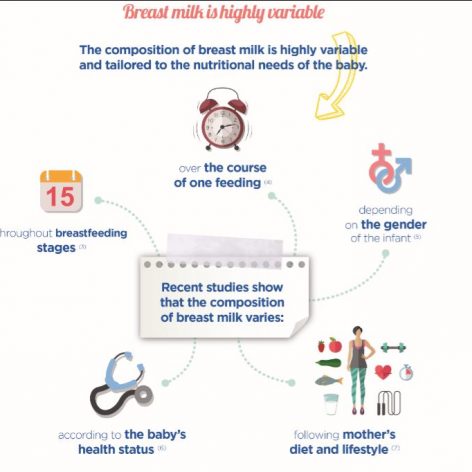Title: Human Milk Composition and Dietary Intakes of Breastfeeding Women of Different Ethnicity from the Manawatu-Wanganui Region of New Zealand
| Authors: | Christine A. Butts, Duncan I. Hedderley, Thanuja D. Herath , Gunaranjan Paturi, Sarah Glyn-Jones, Frank Wiens, Bernd Stahl and Pramod Gopal |
| Published: | 2018 |
| Journal: | Nutrients 2018, 10, 1231; doi:10.3390/nu10091231 |
Human milk is the best possible nutrition for all infants. It provides the optimal nutritional balance for each individual infant, being specifically adapted and uniquely formulated to fully support their growth and development.
There is limited information available on the nutrient composition of breast milk from NZ mothers.
In this study, the investigators investigated for the 1st time the composition of breast milk of an ethnically mixed population of NZ women as a first representation of the New Zealand national population. Furthermore, this study was set up to determine the dietary nutrient intakes of breastfeeding women, compare these to recommended intakes, to assess if the diets were different between different ethnic groups, and if this had any impact on breastmilk composition
78 mothers (19–42 years of age) of Asian, Māori, Pacific Island, or of European ethnicity living in Manawatu-Wanganui, New Zealand (NZ) provided 3 breast milk samples over a 1-week period (6–8 weeks postpartum). They completed a 3-day food diary and provided information regarding their pregnancy and lactation experiences.
The samples were analyzed for protein, fat, fatty acid profile and carbohydrates and a selection of minerals (calcium, magnesium, selenium, zinc). Breast milk nutrient profiles showed no significant differences between the mothers of different ethnicities in their macronutrient (protein, fat, carbohydrate, and moisture) content. The breast milk of Asian mothers contained significantly higher levels of polyunsaturated fatty acids (PUFAs), omega-3 (n-3) and omega-6 (n-6) fatty acids, docosahexaenoic acid (DHA), and linoleic acids. Arachidonic acid was significantly lower in the breast milk of Māori and Pacific Island women. Dietary intakes of protein, total energy, saturated and polyunsaturated fat, calcium, phosphorus, zinc, iodine, vitamin A equivalents, and folate differed between the ethnic groups, as well as the number of serves of dairy foods, chicken, and legumes.
Learn more about this interesting study here

